A morning in the fresh air out of the school classroom? Of course, the children from the local primary school skipped into the Churchyard of St Thomas, Winchelsea, in a well-ordered crocodile to meet the vicar and learn about the three wildflower circles and the returning swifts and swallows.
The vicar, Jonathan Meyer, introduced Mrs Shirley Meyer, his wife, and Mr Paul Youlten as it was they who organised the planting of these wildflower circles. At first the children were asked what differences they could see between the plants inside the circles to outside the circles. These circles are approximately ten feet across and bordered with stakes and rope. The children all looked closely and, at first shy and quiet, quickly warmed up and realised that it was obvious: there was just grass outside and inside full of flowers. On closer inspection lots of bugs and insects, plus the odd bee were pointed out and caused a lot of excitement. It was quite refreshing and a joy to see them all so interested and then the questions started which Paul Youlten and Shirley Meyer answered admirably. They explained that to start the process they had to plant Yellow Rattle which is a plant that eats grass, which they needed to do as they needed to make a weaker environment first as wildflowers prefer a poor soil with low nutrients. Once the ground had a lot less grass they could then start planting all of the wildflowers that the children could see.
Jonathan Meyer, the vicar, swiftly drew the wildflower Q&A to a close and moved the children closer to the church so they could learn about the returning swifts and swallows to Winchelsea. We were all joined by the simply brilliant Mr Cliff Dean, chair of the Friends of Rye Harbour, and local birdwatching expert and guide.

Swallows usually arrive in the UK in March and mostly have left by the end of October.
Swifts spend less time here: they arrive in late April or early May and head south again round about August. Swifts are actually a sort of dirty brown with a white throat but as they speed around the sky they look quite black. As our summer visitors, if you are used to seeing and hearing them screech overhead, your first one of the season is an utter joy. Although they breed across the UK they are most numerous in the south and east, so lucky for us. Also luckily for us, Winchelsea Wildlife have put up approximately 20 nesting boxes around town.
But we were all standing close to the north side of the church, with medieval scaffolding holes facing east. We were all listening intently to whatever Clive was imparting and pointing out and asking questions, yet, all of our communal gaze kept returning to these tiny holes in the bricks
We saw swifts flying, chasing, screeching, possibly snoozing, maybe eating but hopefully not having sex, as they do all of this on the wing. Then the triumph: a tiny swift (they are about 16cm long with a wingspan of about 45cm all packaged into a tiny body weighing between 36-50g) shot out of the brick and we all saw it and we were all amazed.
Clive explained to one great question that if they didn’t land in trees to get away from storms what do they do? They fly around the storm he said. Silence for a moment, then when that sunk in a gasp of amazement. Mine may have been a little too loud. Swifts are monogamous and possibly the oldest swift recorded was 18 years old and with very regular round trips from Africa to the UK; it can clock up more than a million kilometres in the air.

The talk was over and the children were in the church looking at flowers within about 35 minutes of arriving in the churchyard. Too much information crammed in such a short time? Later that day two of the kids in the class came over and we talked some more about it and they were definitely more nature interested.
Image Credits: Kim Zanes .



